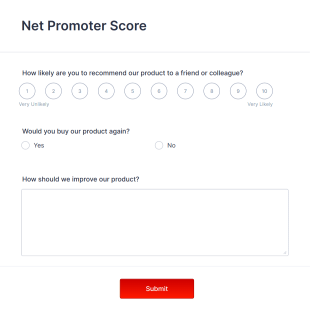Net Promoter Score Form FAQs
1) How do you create a Net Promoter Score survey?
Creating a net promoter score survey is easy. First, formulate some questions to determine customer sentiment. Once you’ve settled on the questions, you can use a free online survey tool like Jotform to easily create and share the survey. And after you receive enough responses, you can collate the data to calculate your net promoter score (NPS).
2) How do you create an NPS survey in Excel?
Excel is a great platform for organizing customer feedback data. To create a survey, log into OneDrive. From there, click on New and select Forms Survey, which will open the Survey Editor window. In the Survey Editor window, provide the title and description. Adding these fields will let participants know what you expect of them and why you’re conducting the survey.
Add the questions you want to ask to the survey. Click the Add new button and select the type of question you want to ask. Excel includes a variety of question types, including text, rating, multiple-choice, and date questions. Rating questions work great for the standard NPS survey format, but don’t be afraid to get creative.
3) How many questions should an NPS survey have?
Keep NPS surveys as short as possible to maximize response rates. Studies have shown that surveys with more than 10 questions tend to see lower response rates, so it’s better to keep surveys brief and focused on the most relevant questions. With that said, the length of an NPS survey will vary depending on the specific context and goals of the survey.
4) What’s a good sample size for an NPS survey?
A good sample size for an NPS survey will vary depending on the population you’re surveying and the margin of error you’re willing to accept. Generally, you should sample at least 500 people to get a reliable net promoter score. If your target audience is a large and diverse population, you may want to increase your sample size for a more accurate score. Keep in mind that the more people you survey, the more time and money it will cost.
5) What is a good NPS score?
A good NPS score is one that’s high enough to indicate that customers are satisfied with a company’s products or services. A score of 50 or higher is generally considered good, but this will vary depending on the industry. For example, a score of 50 is considered excellent in the software industry, but the banking industry would consider it average.
6) NPS survey questions
Typically, NPS questions include a rating scale from 0 to 10 so it’s easy to quantify responses quickly. However, to gain context around extremes (excellent or terrible ratings), it’s often helpful to include open-ended questions. Below are a few questions you might see in a typical NPS survey:
- How likely are you to recommend our product to a friend or colleague? This question is a rating scale question that’s short and simple. It provides measurable responses that businesses can learn from. If someone is willing to recommend your product, then they likely had a good experience — and vice versa.
- Would you buy our product again? A customer’s willingness to buy again is a great indicator of a positive customer experience. Additionally, it likely means that they perceive your product as one of the best in the market. (Note: This perception may depend on price point or perceived value.)
- How could we improve our product? Asking about possible improvements allows customers to share optimizations that they wouldn’t list as shortcomings. For example, maybe a competitor offers a nonessential feature that you don’t, and your customers find that feature appealing.
























